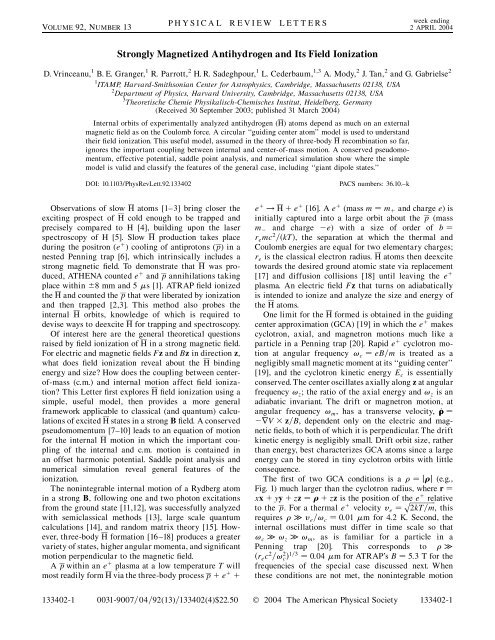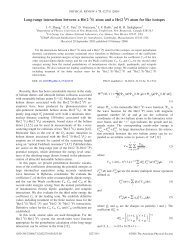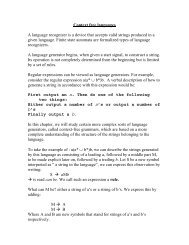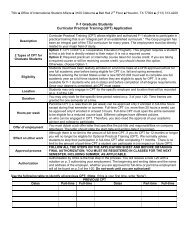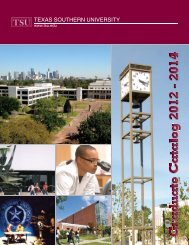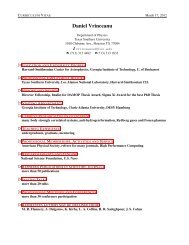Strongly Magnetized Antihydrogen and Its Field Ionization - Physics
Strongly Magnetized Antihydrogen and Its Field Ionization - Physics
Strongly Magnetized Antihydrogen and Its Field Ionization - Physics
- No tags were found...
Create successful ePaper yourself
Turn your PDF publications into a flip-book with our unique Google optimized e-Paper software.
VOLUME 92, NUMBER 13PHYSICAL REVIEW LETTERS week ending2 APRIL 2004<strong>Strongly</strong> <strong>Magnetized</strong> <strong>Antihydrogen</strong> <strong>and</strong> <strong>Its</strong> <strong>Field</strong> <strong>Ionization</strong>D. Vrinceanu, 1 B. E. Granger, 1 R. Parrott, 2 H. R. Sadeghpour, 1 L. Cederbaum, 1,3 A. Mody, 2 J. Tan, 2 <strong>and</strong> G. Gabrielse 21 ITAMP, Harvard-Smithsonian Center for Astrophysics, Cambridge, Massachusetts 02138, USA2 Department of <strong>Physics</strong>, Harvard University, Cambridge, Massachusetts 02138, USA3 Theoretische Chemie Physikalisch-Chemisches Institut, Heidelberg, Germany(Received 30 September 2003; published 31 March 2004)Internal orbits of experimentally analyzed antihydrogen (H) atoms depend as much on an externalmagnetic field as on the Coulomb force. A circular ‘‘guiding center atom’’ model is used to underst<strong>and</strong>their field ionization. This useful model, assumed in the theory of three-body H recombination so far,ignores the important coupling between internal <strong>and</strong> center-of-mass motion. A conserved pseudomomentum,effective potential, saddle point analysis, <strong>and</strong> numerical simulation show where the simplemodel is valid <strong>and</strong> classify the features of the general case, including ‘‘giant dipole states.’’DOI: 10.1103/PhysRevLett.92.133402PACS numbers: 36.10.–kObservations of slow H atoms [1–3] bring closer theexciting prospect of H cold enough to be trapped <strong>and</strong>precisely compared to H [4], building upon the laserspectroscopy of H [5]. Slow H production takes placeduring the positron (e ) cooling of antiprotons (p) inanested Penning trap [6], which intrinsically includes astrong magnetic field. To demonstrate that H was produced,ATHENA counted e <strong>and</strong> p annihilations takingplace within 8mm<strong>and</strong> 5 s [1]. ATRAP field ionizedthe H <strong>and</strong> counted the p that were liberated by ionization<strong>and</strong> then trapped [2,3]. This method also probes theinternal H orbits, knowledge of which is required todevise ways to deexcite H for trapping <strong>and</strong> spectroscopy.Of interest here are the general theoretical questionsraised by field ionization of H in a strong magnetic field.For electric <strong>and</strong> magnetic fields Fz <strong>and</strong> Bz in direction z,what does field ionization reveal about the H bindingenergy <strong>and</strong> size? How does the coupling between centerof-mass(c.m.) <strong>and</strong> internal motion affect field ionization?This Letter first explores H field ionization using asimple, useful model, then provides a more generalframework applicable to classical (<strong>and</strong> quantum) calculationsof excited H states in a strong B field. A conservedpseudomomentum [7–10] leads to an equation of motionfor the internal H motion in which the important couplingof the internal <strong>and</strong> c.m. motion is contained inan offset harmonic potential. Saddle point analysis <strong>and</strong>numerical simulation reveal general features of theionization.The nonintegrable internal motion of a Rydberg atomin a strong B, following one <strong>and</strong> two photon excitationsfrom the ground state [11,12], was successfully analyzedwith semiclassical methods [13], large scale quantumcalculations [14], <strong>and</strong> r<strong>and</strong>om matrix theory [15]. However,three-body H formation [16–18] produces a greatervariety of states, higher angular momenta, <strong>and</strong> significantmotion perpendicular to the magnetic field.A p within an e plasma at a low temperature T willmost readily form H via the three-body process p ee ! H e [16]. A e (mass m m <strong>and</strong> charge e) isinitially captured into a large orbit about the p (massm <strong>and</strong> charge e) with a size of order of br e mc 2 = kT , the separation at which the thermal <strong>and</strong>Coulomb energies are equal for two elementary charges;r e is the classical electron radius. H atoms then deexcitetowards the desired ground atomic state via replacement[17] <strong>and</strong> diffusion collisions [18] until leaving the eplasma. An electric field Fz that turns on adiabaticallyis intended to ionize <strong>and</strong> analyze the size <strong>and</strong> energy ofthe H atoms.One limit for the H formed is obtained in the guidingcenter approximation (GCA) [19] in which the e makescyclotron, axial, <strong>and</strong> magnetron motions much like aparticle in a Penning trap [20]. Rapid e cyclotron motionat angular frequency ! c eB=m is treated as anegligibly small magnetic moment at its ‘‘guiding center’’[19], <strong>and</strong> the cyclotron kinetic energy E c is essentiallyconserved. The center oscillates axially along z at angularfrequency ! z ; the ratio of the axial energy <strong>and</strong> ! z is anadiabatic invariant. The drift or magnetron motion, atangular frequency ! m , has a transverse velocity, _rV z=B, dependent only on the electric <strong>and</strong> magneticfields, to both of which it is perpendicular. The driftkinetic energy is negligibly small. Drift orbit size, ratherthan energy, best characterizes GCA atoms since a largeenergy can be stored in tiny cyclotron orbits with littleconsequence.The first of two GCA conditions is a j j (e.g.,Fig. 1) much larger than the cyclotron radius, where rxx yy zz zz is the position of the p e relativeto the p. For a thermal e velocity v e 2kT=m,thisrequires v e =! c 0:01 m for 4.2 K. Second, theinternal oscillations must differ in time scale so that! c ! z ! m , as is familiar for a particle in aPenning trap [20]. This corresponds tor e c 2 =! 2 c 1=3 0:04 m for ATRAP’s B 5:3 Tfor thefrequencies of the special case discussed next. Whenthese conditions are not met, the nonintegrable motion133402-1 0031-9007=04=92(13)=133402(4)$22.50 © 2004 The American Physical Society 133402-1
VOLUME 92, NUMBER 13PHYSICAL REVIEW LETTERS week ending2 APRIL 2004ωcω me +ρ _p(a)ω zBz in µmdrift radius ρ in µm0.30.20.10.40.30.2ρ = 0.5 µmρ = 0.4 µmρ = 0.3 µmρ = 0.2 µm0.00.5 limit, axial energy = 0ρ = 0.1 µmaxial energy = 0.3 meV(kT at 4.2 kelvin)0.1 axial energy = 3 meV(10kT at 4.2 kelvin)0.00 50 100 150 200 250 300 350axial electric field Fz in V/cmFIG. 1. A circular guiding center H atom (a) is polarized (b)<strong>and</strong> ionized (c) by an electric field F is applied along B.(b)(c)in similar strength magnetic <strong>and</strong> Coulomb fields allowsfor chaotic orbits [15].The important special case is the circular GCA atom[Fig. 1(a)] used to calculate rates for three-body formationof magnetized H [17,18] <strong>and</strong> for radiation fromcircular Rydberg states [21], for an axially symmetricV 1=r with no H c.m. motion transverse to B. Theangular frequency p for small axial oscillations (z )is ! z r e c 2 = 3 , <strong>and</strong> the angular drift frequency is! m r e c 2 = ! 3 c . The axial adiabatic invariant meansthat the axial energy E z ! 3=2 z for small z. Theguiding center of an H formed with axial energy E z0 at0 then follows an orbit given by E z0 0 = 3=2V z 0 const in this limit.Circular GCA atoms are polarized or ionized by Fz ina way that depends upon their radial size , but withoutchanging .AsFz is adiabatically added to the Coulombpotential, the calculated center of the axial oscillation ofthe e moves to stay centered in the resultant axialpotential well [the solid curves in Fig. 1(b)]. (For ATRAPF changes adiabatically insofar as H move slowly into theionization field.) This H polarizability can be calculatedanalytically for F small enough that the average z .The average induced dipole is then ez F, with apolarizability e 2 3 = r e mc 2 [dashes in Fig. 1(b)].If we relaxed our assumption that F is spatially uniform,the force on the induced dipole, =2 @=@z F 2 inthe linearized case, would provide a 1D restoring forceon the H to any point for which F 2 is maximum along z.At the origin, a field F cosaz will provide such confinementwhereas a harmonic F z will not.A polarized H ionizes when its e is able to escape theaxial well, which eventually vanishes as F increases. AnH that survives F thus has smaller thanra ep ; (1)F 4 owith a 4=27 1=4 0:62 [Fig. 1(c)] <strong>and</strong> Coulomb constant4 p0. The square root constant is 1 a.u. <strong>and</strong>3:795 m V=cm.Anewith axial energy is ionizedby a smaller F [e.g., Fig. 1(c) for axial energies of kT <strong>and</strong>10kT for T 4:2 K]. A thermal distribution of e axialenergies is predicted due to collisions with other e [17];for axial energy much less than the radialpbinding p energy,jE b j 1= , the limit Eq. (1) is jE b j F =a e 3 = 4 o ,where thispsquare root constant is 1 a.u. <strong>and</strong>0:3795 meV cm=V. Quantum tunneling from the axialwell in the 100 s or less that H travel from production todetection only slightly lowers the curves of Fig. 1(c).Determining where the simple circular model is valid,<strong>and</strong> improving upon it, requires an analysis that includesthe motion of the H c.m., with mass M at position R,neglected so far. The key is a pseudomomentum [7,8]K M _R er B; (2)which is conserved along with the total energy, whichnow is the sum of the energy in the relative <strong>and</strong> c.m.motions. K z is the c.m. momentum parallel to B. Withoutloss of generality we choose y so that K ? K ? y.Forus, K ? distinguishes different types of H states; earlier itwas useful in characterizing how c.m. motion was affectedas internal atomic motion became chaotic [9,10].A simple model estimates the K ? distributions thatmight be expected for formation <strong>and</strong> deexcitation of H(Fig. 2), consistent with a recent simulation [22]. Weassociate a binding energy kT with a radius r b=as would pertain for circular atoms. For three-body formationof H, a capture <strong>and</strong> deexcitation through a ‘‘bottleneck’’at 4 is predicted [17]. The K ? distributionarises from a thermal distribution of c.m. velocities <strong>and</strong> ar<strong>and</strong>om distribution of ; the basic features do not changeif we populate an area of radius b= transverse to B, ashell of this radius (in Fig. 2), or the interior of this shell,so that K ? < 1a:u: is expected.The conservation of K is established directly by thefirst of two equations of motion for H in uniform magnetic<strong>and</strong> electric fields, B <strong>and</strong> F,P(K⊥ )4321r=0r = 0.25 bK critr = 0.5 br = 0.75 b2b=rmc e /kTr=b00 0.5 1 1.5 2K ⊥ (a.u.)FIG. 2 (color). Estimated pseudomomentum K ? distributionsfor H production within a 4.2 K e plasma. For K ? >K critgiant dipole states can exist as we discuss.133402-2 133402-2
VOLUME 92, NUMBER 13PHYSICAL REVIEW LETTERS week ending2 APRIL 20040ddt M _R er BdKdt ; (3)er e _R B e _r 2 rB4 o r 3 eF: (4)Here is the familiar reduced mass, <strong>and</strong> mm =M would vanish for m m (e.g., positronium).Using the conserved K to eliminate explicit referencesto the c.m. motion [9] from Eq. (4) yields an equationinvolving only the relative coordinates,r rV r e _r B; (5)for a charge e <strong>and</strong> mass in an effective magnetic fieldB B <strong>and</strong> an effective potential1V r2 M 2 c x21 e 2o eF r: (6)4 0 rCoupling to the c.m. motion is completely described bythe harmonic term with an offset x 0 K ? ^x= eB <strong>and</strong> astrength given by c eB=M—nearly the p cyclotronfrequency. Figure 3 shows equipotentials <strong>and</strong> projectionsof V r for K ? 1a:u: As K ? increases above K crit3e MB= 16 01=3 , a giant dipole well emerges as aconsequence of the coupling to the c.m. motion [10].The relative equation of motion corresponds to a conservedHamiltonian, H 1 2_r 2 V r [10], where _rp eA r is related to the canonical momentum p <strong>and</strong>the vector potential A in the usual way. The internal H1energy is E rel 2_r 2 e 2 = 4 0r . The alternate form,H 1 2 M _R 2 ?E rel , emphasizes that total energy is conservedwhile E rel is not.Figure 4 illustrates different types of regular driftorbits. The GCA is valid over the area shown, exceptvery close to the Coulomb center ( ), where
VOLUME 92, NUMBER 13PHYSICAL REVIEW LETTERS week ending2 APRIL 2004y( µ m)y( µ m)-0.4 0.0 0.4-0.1 0.0 0.1 0.2drift radius ρ (µ m)(a) K = 0.0 a.u.yF = 60 V/cmF = 20 V/cm-0.4 0.0 0.4(d) K = 0.0 a.u.yF = 360 V/cmF = 250 V/cm0.50.40.30.2-0.10.1(b) K = 0.2 a.u.yF = 60 V/cmF = 20 V/cm-0.4 0.0 0.4x( µ m)(e) K = 0.2 a.u.yF = 360 V/cmF = 250 V/cm-0.1 0.1x( µ m)(c) K = 1.0 a.u.yF = 20 V/cm-0.4F = 60 V/cmF = 250 V/cm0.0 0.4(f) K = 1.0 a.u.y-0.1F = 360 V/cmlimit of vanishing axial wellnumerical simulations:0.1saddle point analysis0.00 50 100 150 200 250 300 350electric field F z (V/cm)velocities <strong>and</strong> reasonably small K ? despite the couplingto relative motion, as confirmed by simulations [22]. Bothr B <strong>and</strong> _R in Eq. (2) oscillate at relative oscillationfrequencies to keep K independent of time. Since thecorresponding periods are short compared to the transittime of an H through the apparatus, the effect of theseoscillations on the c.m. motion averages away.Spatial gradients in F (e.g., due to the relatively weakfields of the nested Penning trap) have not been includedin our analysis. Doing so adds er r 0 F r 0 j r0R to theright of Eq. (3), <strong>and</strong> the sum of this term <strong>and</strong> eF Rreplace eF in Eq. (5). K ? is not conserved <strong>and</strong> coupledequations for the c.m. <strong>and</strong> relative motion must be solved.<strong>Field</strong>s from harmonic potentials are simple in that thegradient terms are independent of R, butK ? is still notconserved <strong>and</strong> F R still couples the relative <strong>and</strong> c.m.equations. For the special case F z z (e.g., for ATRAPH traveling into the prestripping field), K ? is conserved<strong>and</strong> Eq. (5) is unchanged. The coupled c.m. <strong>and</strong> relativeaxial equations describe the polarization of the H <strong>and</strong> theforce on this induced moment; for ATRAP this slightlyspeeds the H motion to the detection well.0.1(g)K y = 0.0 a.u.K y = 0.2 a.u.K y = 1.0 a.u.FIG. 5 (color). Numerical simulations for z 0 identify Horbits that are stable against ionization by Fz applied adiabaticallyfor various values of K ? k y <strong>and</strong> F in (a)–(f). Hsurviving a field F must have radii lower than that shown in (g).In conclusion, a conserved pseudomomentum allowsthe analysis of coupled internal <strong>and</strong> c.m. motions formagnetized H atoms <strong>and</strong> provides a general frameworkfor improved classical <strong>and</strong> quantum calculations of theformation of such atoms. A classical analysis shows that Hc.m. motion in a strong B produces unusual internal Horbits, some with large electric dipoles. This generalapproach shows that a simple circular atom model, combinedwith a saddle point analysis <strong>and</strong> numerical simulations,gives a consistent picture of the relationshipbetween the size of an H <strong>and</strong> the field that ionizes it,thus supporting the usefulness of the ATRAP field ionizationmethod. The analysis shows that orbits with largeelectric dipoles ionize so easily that they have not yetbeen observed experimentally, <strong>and</strong> that the coupling betweenH center-of-mass <strong>and</strong> internal motion is less of acomplication for H moving along the magnetic fielddirection, the configuration used by ATRAP.This work was supported by NSF, AFOSR, <strong>and</strong> ONR.[1] M. Amoretti et al., Nature (London) 419, 456 (2002).[2] G. Gabrielse et al., Phys. Rev. Lett. 89, 213401 (2002).[3] G. Gabrielse et al., Phys. Rev. Lett. 89, 233401 (2002).[4] G. Gabrielse, in Fundamental Symmetries, edited byP. Bloch, P. Paulopoulos, <strong>and</strong> R. Klapisch (Plenum,New York, 1987), p. 59.[5] C. Zimmerman <strong>and</strong> T.W. Hänsch, Hyperfine Interact. 76,47 (1993).[6] G. Gabrielse et al., Phys. Lett. B 507, 1 (2001).[7] B. P. Carter, J. Math. Phys. (N.Y.) 10, 788 (1969).[8] J. E. Avron, I.W. Herbst, <strong>and</strong> B. Simon, Ann. Phys. (N.Y.)114, 431 (1978).[9] P. Schmelcher <strong>and</strong> L. S. Cederbaum, Comments Mod.Phys. D 2, 123 (2000).[10] O. Dippel, P. Schmelcher, <strong>and</strong> L. S. Cederbaum, Phys.Rev. A 49, 4415 (1994).[11] G. Littman, M. M. Kash, <strong>and</strong> D. Kleppner, Phys. Rev.Lett. 41, 103 (1978).[12] J. Main, G. Wiebusch, A. Holle, <strong>and</strong> K. H. Welge, Phys.Rev. Lett. 57, 2789 (1986).[13] M. L. Du <strong>and</strong> J. B. Delos, Phys. Rev. A 38, 1896 (1988).[14] C.W. Clark <strong>and</strong> K. T. Taylor, J. Phys. B 13, L737 (1980).[15] D. Del<strong>and</strong>e <strong>and</strong> J. C. Gay, Phys. Rev. Lett. 57, 2006(1986).[16] G. Gabrielse, S. L. Rolston, L. Haarsma, <strong>and</strong> W. Kells,Phys. Lett. A 129, 38 (1988).[17] M. Glinsky <strong>and</strong> T. O’Neil, Phys. Fluids B 3, 1279 (1991).[18] P. O. Fedichev, Phys. Lett. A 226, 289 (1997).[19] B. Lehnert, Dynamics of Charged Particles (Wiley, NewYork, 1964).[20] L. S. Brown <strong>and</strong> G. Gabrielse, Rev. Mod. Phys. 58, 233(1986).[21] J. R. Guest, J.-H. Choi, <strong>and</strong> G. Raithel, Phys. Rev. A 68,022509 (2003).[22] F. Robicheaux (private communication).[23] T. F. Gallagher, Rydberg Atoms (Cambridge UniversityPress, New York, 1994).133402-4 133402-4


